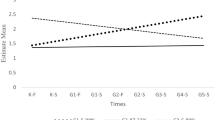Abstract
We focused on the stability of child problem behaviors in a sample of 124 low-income inner-city African American families. Internalizing and externalizing problems were assessed longitudinally across four years. Test-retest correlation coefficients indicated that the relative stability of both internalizing and externalizing problems over the four-year assessment was high for both child and mother reported variables. Partial support was obtained for absolute stability of child problem behavior as analyses of variance revealed that two of four variables of interest did not change significantly over time. Mother report of child problem behavior was more stable than child report, but gender of child or type of problem behavior (internalizing vs. externalizing) was not related to stability. Hierarchical multiple regression analyses revealed that the historical context of child problem behaviors is important to consider, as earlier problem behaviors accounted for unique variance in later problem behaviors, beyond that accounted for the most recent assessment.
Similar content being viewed by others
References
Achenbach, T. (1991a). Manual for the Child Behavior Checklist 4—18 and 1991 Profile. Burlington, VT: University of Vermont Department of Psychiatry.
Achenbach, T. (1991b). Manual for the Youth Self-Report and 1991 Profile. Burlington, VT: University of Vermont Department of Psychiatry.
Alder, A.G., & Scher, S.J. (1994). Using growth curve analyses to assess peronality change and stability in adulthood. In T. F. Heatherton & J. L. Weinberger (Eds.), Can personality change? (pp. 149-173). Washington, DC: American Psychological Association.
Biederman, J., Monuteaux, M.C., Greene, R.W., Braaten, E., Doyle, A.E., & Faraone, S.V. (2001). Long-term stability of the child behavior checklist in a clinical sample of youth with attention deficit hyperactivity disorder. Journal of Clinical Child Psychology, 30, 492-502.
Campbell, S.B., Pierce, E.W., Moore, G., Marakovitz, S., & Newby, K. (1996). Boys' externalizing problems at elementary school age: Pathways from early behavior problems, maternal control, and family stress. Development and Psychopathology, 8, 701-719.
Cicchetti, D. (1990). A historical perspective on the discipline of developmental psychopathology. In J. Rolf, A. S. Amsten, D. Cicchetti, K. H. Neuchterlein, & S. Weintraub (Eds.), Risk and protective factors in the development of psychopathology (pp. 2-28). New York: Cambridge University.
Denham, S.A., Workman, E., Cole, P.M., Weissbrod, C., Kendziora, K.T., & Zahn-Waxler, C. (2000). Prediction of externalizing behavior problems from early to middle childhood: The role of parental socialization and emotion expression. Development and Psychopathology, 12, 23-45.
Fitzpatrick, K. (1993). Exposure to violence and presence of depression among low-income, African American youth. Journal of Consulting and Clinical Psychology, 61, 528-531.
Heller, T.L., Baker, B.L., & Henker, B. (1996). Externalizing behavior and cognitive functioning from preschool to first grade: Stability and predictors. Journal of Clinical Child Psychology, 25, 376-387.
Hofstra, M.B., der Ende, J.V., & Verhulst, F.C. (2000). Continuity and change of psychopathology from childhood into adulthood: A 14-year follow-up study. Journal of the Academy of Child and Adolescent Psychiatry, 39, 850-858.
Kann, L., Kinchen, S., Williams, B., Ross, J., Lowry, R., Hill, C., Grunbaum, J., Blumson, P., Collins, J., Kolbe, L., & State and Local YRBSS Coordinators (1998). Youth Risk Behavior Surveillance-United States, 1997. MMWR, 47, 1-89.
Kovacs, M. (1981). Rating scales to assess depression in school-aged children. Acta Paedopsychiatrica, 46, 305-314.
Loeber, R., Drinkwater, M., Yin, Y., Anderson, S.J., Schmidt, L.C., & Crawford, A. (2000). Stability of family interaction from ages 6 to 18. Journal of Abnormal Child Psychology, 28, 353-369.
Luthar, S. (1999). Poverty and children's adjustment. Thousand Oaks: Sage Publications.McConaughy, S. H., Stanger, C., & Achenbach, T. M. (1992). Three-year course of behavioral/emotional problems in a sample of 4-to 16-year olds: I. Agreement among informants. Journal of the Academy of Child and Adolescent Psychiatry, 31, 932-940.
Shaffer, A., Forehand, R., Kotchick, B.A., & the Family Health Project Research Group (in press). A longitudinal examination of the correlates of depressive symptoms among inner-city African American children and adolescents. Journal of Child and Family Studies.
Silverthorn, P., & Frick, P. J. (1999). Developmental pathways to antisocial behavior: The delayed-onset pathway in girls. Development and Psychopathology, 11, 101-126.
Stanger, C., Achenbach, T. M., & Verhulst, F. C. (1997). Accelerated longitudinal comparisons of aggressive versus delinquent syndromes. Development and Psychopathology, 9, 43-58.
Stoolmiller, M. (1994). Antisocial behavior, delinquent peer association, and unsupervised wandering for boys: Growth and change from childhood to early adolescence. Multivariate Behavioral Research, 29, 263-288.
Tieti, Q.Q., Wasserman, G.A., Loeber, R., McReynolds, L.S., & Miller, L.S. (2001). Development and sex differences in types of conduct problems. Journal of Child and Family Studies, 10, 181-197.
Visser, J.H., van der Ende, J., Koot, H.M., & Verhulst, F.C. (1999). Continuity of psychopathology in youths referred to mental health services. Journal of the Academy of Child and Adolescent Psychiatry, 38, 1560-1568.S
Verhulst, F., Koot, H., & Berden, G. (1990). Four-year follow-up of an epidemiological sample. Journal of the Academy of Child and Adolescent Psychiatry, 29, 440-448.
Zoot, H.M. (1995). Longitudinal studies of general population and community samples. In F.C. Verhulst & H.M. Koot (Eds.), The epidemiology of child and adolescent psychopathology (pp. 337-365). Oxford: Oxford University.
Author information
Authors and Affiliations
Rights and permissions
About this article
Cite this article
Jones, D.J., Forehand, G. The Stability of Child Problem Behaviors: A Longitudinal Analysis of Inner-City African American Children. Journal of Child and Family Studies 12, 215–227 (2003). https://doi.org/10.1023/A:1022814900577
Issue Date:
DOI: https://doi.org/10.1023/A:1022814900577




